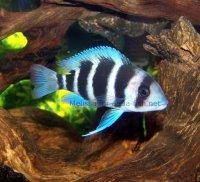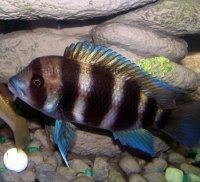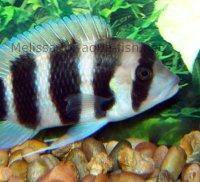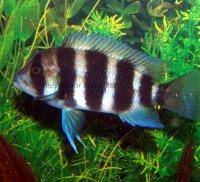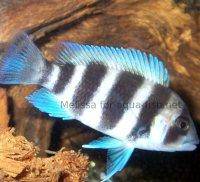Frontosa Cichlid - Aquarium care, diet, sexing, breeding & more
Quick links - Answers
Brief Description
This page covers every aspect of raising Frontosa cichlids in fish tanks; From aquarium set-up to variations of this specie. Use a form at the bottom of this page in case you can't find answer on your question, sharing experiences is welcome too - we'd love to hear about your Frontosa's!
Introduction
The Cyphotilapia frontosa is named Cypho- meaning “hump” in Greek, -tilapia meaning “fish” in Tswana (the language spoken around lake Ngami), and frontosa based on the Latin word Frontis meaning “with big forehead.” Nicknamed frontosa, this very distinguishable fish is a highly prized and highly priced cichlid in the aquarium industry. The more common variation in retail is from Burundi which can run anywhere from $12 to $15 for juveniles. Other variations can be considerably more expensive because of their vibrant blue coloration and the fact that they are not as easy to breed. They can cost around $250 for the juveniles. Despite the high price, these fish are definitely worth the investment because they are an attractive and hardy species that can live up to 25 years.
Behaviour
Frontosas are hunters who like to work smart, not hard. They hunt for food at dusk, just when their prey would be falling asleep thus making themselves easy targets. In an aquarium setting this fish will eat a variety of frozen and live foods in addition to prepared flakes and pellets. These carnivorous predators are best kept in large groups much like the colonies they are found in naturally but they require an abundance of space because of their potential size. Multiple males can be kept together for this particular species as long as you provide them with adequate hiding places that are large enough for them to dart in and out of. Be sure to secure rocks and caves so that injuries do not occur when they do retreat clumsily. I say they are clumsy because they are not conditioned to moving quickly unless there is a need to do so, for this reason, they are much more graceful at a slower pace.
Water conditions
It is very important for frontosas to feel safe and secure. Keep them in a tank no smaller than 85 gallons with plenty of rocky caves for the males. The females should have the option for a hiding place as well but they do not require them as the males do. This type of fish likes subdued lighting because it mimics the lighting of their natural habitat in the deeper regions of the lake. Bright light makes them feel more anxious and exposed. Frontosas are sensitive to chemicals and pollutants so be sure to do frequent partial water changes. Keep your aquarium between 75º- 79ºF with moderate to hard water and an alkaline pH ranging from 7.8 to 9.5. Frontosas like to dig in sandy substrates but if you have gravel they will dig in that too. They are known to dig up plants even if they are securely rooted, but they are not likely to shred them as many other cichlids would.
Sexing
Sexing for this species is commonly determined by the hump on the head which tends to be larger on males and smaller on females. However this is not a reliable way for sexing juveniles because the hump comes about with maturity in both sexes. As frontosas start to mature, the male will grow quite a bit larger and faster that the female. It takes years for this species to reach sexual maturity and the number of years depends on the different variations. Some can take up to 3 years to become sexually mature.
Breeding
Frontosas are mouth-brooders that do not perform the usual courting rituals. There is no display of fins and no showy dance performed by the male for the female. It’s a fairly straight forward procedure when the male excavates his cave in order to make it presentable for the female to want to enter. Upon entering his cave, the female lays her eggs on a spot that he has cleared for her. The male then fertilizes the eggs followed by the female scooping them up into her mouth. The female will produce about 50 of these large eggs and keep them in her mouth as mouth-brooders do. This is when you will want to remove the male so that he will not have the chance to devour the brood. The mother will keep the fry in her mouth for as long as two months. The fry are relatively large and grow relatively quickly; they will eat a variety of foods once they are released.
When breeding frontosas, be sure to keep the different variations separate because mixing them can result in deformed or sterile offspring.
Variations
The true Cyphotilapia frontosa, the only one of these species with seven stripes, comes from one specific region along Lake Tanganyika, which is Kigoma. What used to be classified as C. frontosa from the regions Mpimbwe, Zaire and Zambia, are now classified under a different name: Cyphotilapia gibberosa. There are subtle, yet very technical differences that set the frontosa apart from the gibberosa like the size and shape of the hump, number of scales and slight fin variations. With the frontosa and gibberosa species so clearly defined the only thing left to do is to rename the variations that come from Burundi, Kavala and Karilani. It is only a matter of time before experts come up with those new names. However, in the retail aquarium industry I believe the popular name “frontosa” will generically still be used by the common hobbyist for all the different variations of this species.
Despite the very common appearance of all the different varieties of frontosa, these fish come from varying depths all over Lake Tanganyika from as shallow as 15 feet to as deep as 180 feet. Much like humans, these fish have to go through the same decompression phases when coming up from the extreme depths. Bringing up these fish too quickly enlarges their swim bladder until their intestines are literally forced out of their body.
The most popular variations of Cyphotilapia are from Burundi, Kavala and Karilani.
- The Burundi is the absolute most common of them all with six stripes and as it matures a large hump on its head. The coloration is not as elaborate and blue as some of the other variations but there is quite a bit of the blue coloration in the fins and a little in the face.
- The Kavala variant is found at shallower depths of 15 to 20 feet and exhibits a pearlescent shade of white in its stripes. There is a slight yellow tint in the coloration of its dorsal fin which causes it to appear more iridescent.
- The Karilani is blue in the fins and face like the Burundi version and additionally has more blue on the body. The dorsal fin of this variation has a gold-ish coloration with a blue stripe on the edge of the fin.
The less popular species but are still important to mention are from Kigoma, Mpimbwe, Zaire and Zambia.
- The Kigoma is the only true C. frontosa, as it was the original type specimen described. This fish is the only one with seven stripes and a black mark below the eye. This true frontosa will develop a large hump and a blue face with the yellow sheen in the dorsal fin.
- The Mpimbwe C. gibberosa is set apart from the rest due to its unusual character. This fish is not shy and has been known to eat straight from a person’s hand. The blue coloring of this variation is a bright blue in much of the fins and body.
- The Zaire C. gibberosa is the most brilliantly colored of them all. The blue on this fish is so exquisite that they have become the ultimately preferred version. The only problem is they are notably harder to breed than the more common types. The nuchal hump on the head of this fish does not grow as large as the others and this is the deepest variant found between 120-180 feet.
- The Zambia C. gibberosa is the final variation of this species to be mentioned. It has less blue than the Zaire and Mpimbwe C. gibberosas but the contrasting black and white stripes and the dramatically blue face are what set this fish apart from the afore mentioned varieties. This is another variant that is quite hard to breed.
Pictures
Resources
- Encyclopedia of Aquarium & Pond Fish by David Alderton
- Focus on Freshwater Aquarium Fish by Geoff Rogers and Nick Fletcher
- Aquarium Fishes of the World by Dr. Herbert R. Axelrod, Dr. Warren E. Burgess, Neal Pronek, Glen S. Axelrod and David E. Boruchowitz






